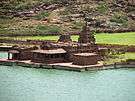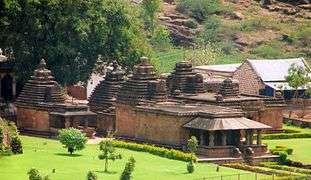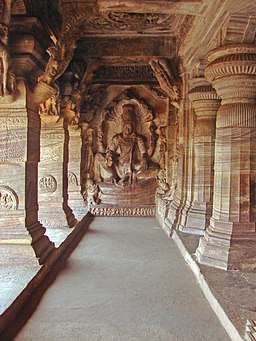Badami
Badami, formerly known as Vatapi, is a town and headquarters of a taluk by the same name, in the Bagalkot district of Karnataka, India. It was the regal capital of the Badami Chalukyas from AD 540 to 757. It is famous for its rock cut structural temples. It is located in a ravine at the foot of a rugged, red sandstone outcrop that surrounds Agastya lake. Badami has been selected as one of the heritage cities for HRIDAY - Heritage City Development and Augmentation Yojana scheme of Government of India.
Badami Vatapi | |
|---|---|
Town | |
Badami Cave Temples | |
| Coordinates: 15°55′12″N 75°40′49″E | |
| Country | |
| State | Karnataka |
| District | Bagalkot |
| Area | |
| • Total | 10.9 km2 (4.2 sq mi) |
| Elevation | 586 m (1,923 ft) |
| Population (2011)[1] | |
| • Total | 30,943 |
| • Density | 2,800/km2 (7,400/sq mi) |
| Languages | |
| • Official | Kannada[2] |
| Time zone | UTC+5:30 (IST) |
| PIN | 587 201 |
| Telephone code | 08357 |
History
- Dravidian architecture - Badami Chalukyas
- Hindu temple architecture - Badami Chalukya architecture
- Political history of medieval Karnataka - Badami Chalukyas
- Architecture of Karnataka - Badami Chalukya architecture
- Chalukyas of Badami
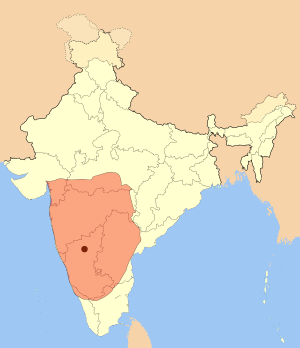
Pre-historic
The Badami region was settled in pre-historic times, with evidence by megalithic dolmens.[3]
Historic
- Mythology
The Puranas state the wicked asura Vatapi was killed by sage Agastya, and it refers to this area as Vatapi and Agastya Tirtha. In the Ramayana, Agastya and Lopamudra are described as living in Dandaka forest, on the southern slopes of Vindhya mountains. Rama praises Agastya as the one who can do what gods find impossible. He is described as the sage who used his Dharma powers to kill demons Vatapi and Ilwala after they had jointly misled and destroyed 9,000 men.[4]
In the Mahabharata, sage Agastya is described in the epic as a sage with enormous powers of ingestion and digestion. To kill men, asura Vatapi used to become a goat and his brother Ilvala would cook him. Then, Vatapi would recollect in the stomach and tear himself out from the inside of the victim, killing the victim. When Agastya arrives, Ilvala offers the goat again. He kills Vatapi by digesting the meal as soon as he ate, giving Vatapi no time to self organize.[5] Agastya, in the legends of Mahabharata, kills the demons Vatapi and Ilvala much the same mythical way as in the Ramayana.[6]
- Kingdoms
Badami Chalukyas was founded in AD 540 by Pulakeshin I (AD 535–566), an early ruler of the Chalukyas is generally regarded as the founder of the Early Chalukya line. An inscription record of this king engraved on a boulder in Badami records the fortification of the hill above "Vatapi" in 544. Pulakeshin's choice of this location for his capital was no doubt dedicated by strategic considerations since Badami is protected on three sides by rugged sandstone cliffs. His sons Kirtivarman I (AD 567–598) and his brother Mangalesha (AD 598–610) constructed the cave temples. Kirtivarman I strengthened Vatapi and had three sons Pulakeshin II, Vishnuvardhana and Buddhavarasa, who at his death were minors, thus making them ineligible to rule, so Kirtivarman I's brother Mangalesha took the throne and tried to establish rule, only to be killed by Pulakeshin II who ruled between AD 610 to 642.[7] Vatapi was the capital of the Early Chalukyas, who ruled much of Karnataka, Maharashtra, parts of Tamil Nadu and Andhra Pradesh between the 6th and 8th centuries. The greatest among them was Pulakeshin II (AD 610–642) who defeated many kings including the Pallavas of Kanchipuram.
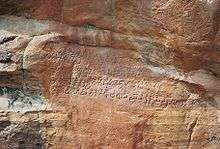
The rock-cut Badami Cave Temples were sculpted mostly between the 6th and 8th centuries.[8]
Inscriptions
Badami has eighteen inscriptions, among them some inscriptions are important. The first Sanskrit inscription in old Kannada script, on a hillock dates back to 543 CE, from the period of Pulakeshin I (Vallabheswara), the second is the 578 CE cave inscription of Mangalesha in Kannada language and script and the third is the Kappe Arabhatta records, the earliest available Kannada poetry in tripadi (three line) metre.[9][10][11] one inscription near the Bhuthanatha temple also has inscriptions dating back to the 12th century in Jain rock-cut temple dedicated to the Tirtankara Adinatha.
Sites
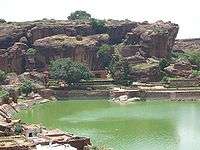 Agastya lake
Agastya lake Bhutanatha temple complex, next to a waterfall, during the monsoon.
Bhutanatha temple complex, next to a waterfall, during the monsoon.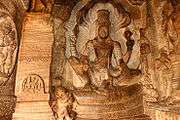 Vishnu seated on Adishesha
Vishnu seated on Adishesha Brahma on Hamsa in Cave 3 ceiling
Brahma on Hamsa in Cave 3 ceiling.jpg) Bahubali in cave 4
Bahubali in cave 4 Jain Parshvanatha in cave 4
Jain Parshvanatha in cave 4%2C_Shiva_above_Nandi%2C_Brahma_above_Hamsa%2C_Badami_monuments_Karnataka.jpg) Vishnu, Shiva and Brahma in a small rock carving monument
Vishnu, Shiva and Brahma in a small rock carving monument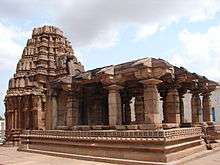 Yellamma temple at Badami, early phase construction, 11th century
Yellamma temple at Badami, early phase construction, 11th century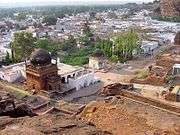 Mosque in Badami
Mosque in Badami Northern Fort Temple
Northern Fort Temple
Administration
Government
It is a town in the Bagalkot District in Karnataka state, India. It is also headquarters of Badami Taluk in the district.
Taluka
The Badami Taluka has thirty-four panchayat villages:[12]
|
|
|
|
Geography
Badami is located at 15.92°N 75.68°E.[13] It has an average elevation of 586 metres (1922 ft). It is located at the mouth of a ravine between two rocky hills and surrounds Agastya tirtha water reservoir on the three other sides. The total area of the town is 10.3 square kilometers.
It is located 30 kilometers from Bagalkot, 128 kilometers from Bijapur, 132 kilometers from Hubli, 46 kilometers from Aihole, another ancient town, and 589 kilometers from Bangalore,[14] the state capital.
Climate
- Summer – March to June
- Spring – Jan to March
- Monsoons – July to October that contributes to rainfall
- Winter – November to Jan
The temperature ranges from minimum 23 degrees to 45 degrees during summer and from 15 to 29 degrees in winter. The rainfall of the area is 50 centimeters. Best time to visit is between low humid season from November and March.
The climate has made it a safe haven for the monkeys of south India. Tourists often flock to Badami for the opportunity to see monkeys interact in a natural environment.
Demographics
As of 2011 Indian Census, Badami had a total population of 30,943, of which 15,539 were males and 15,404 were females. Population within the age group of 0 to 6 years was 3,877. The total number of literates in Badami was 22,093, which constituted 71.4% of the population with male literacy of 78.1% and female literacy of 64.7%. The effective literacy rate of 7+ population of Badami was 81.6%, of which male literacy rate was 89.7% and female literacy rate was 73.6%. The Scheduled Castes and Scheduled Tribes population was 4,562 and 1,833 respectively. Badami had 6214 households in 2011.[1]
As of the 2001 Indian census,[15] Badami had a population of 25,851. Males constituted 51% of the population and females 49%. Badami had an average literacy rate of 64.8%, comparable to the national average of 65%; with 59% of the males and 41% of females literate. 14% of the population was under 6 years of age.
The main language is Kannada.
Economy
The main economy is centered around tourism in Karnataka.
Transport
The nearest airport is Hubballi about 105 kilometers away. It is on the Hubli–Solapur rail route, and the rail station is 5 kilometers from the town. It is also connected by road to Hubli and Bijapur. Badami is reachable from Bengalooru by a 12-hour bus ride, or by a direct train "Solapur Gol Gumbaz Exp (train no. 16535)" or with a combination of an overnight train journey from Bangalore to Hospet followed by a short bus ride from Hospet to Badami. Another train journey could be from Bangalore to Hubli (8–9 hours) and then a bus ride to Badami (3 hours). Badami is around 110 km from Hubli. Local transport is by Rickshaws, and city buses.
Climbing
Badami's red sandstone cliffs are popular amongst local and international climbers. This is great location for free sport climbing and bouldering. The cliffs have horizontal crack systems, similar to Gunks. There are over 150 bolted routes and multiple routes for free climbing. Gerhard Schaar,[16] a German Climber and Pranesh Manchaiah, a local climber from Bangalore, were instrumental in setting up the sport routes driving a project called 'Bolts for Bangalore'.[17] National Rock Climbing center, Manager Rajendra Hasabavi in Banshankari Road by General Thimayya National Academy of Adventure, Department of Youth Empowerment and Sports, Govt.of Karnataka is conducting various rock climbing and Adventure Camps for Youth and School Children.
Films shot in Badami
- Guru (2007 film)
- Shirdi Sai, Shakti, Nagavalli, Brindavanam, Dhamarukam, Daruvu
- Shivani, Sanju Weds Geetha
- Mungaru Male
- Vikramarkudu, Veera Madakari, Rowdy Rathore, Siruthai
- Rummy
- Alludu Seenu
See also
|
|
References
- "Census of India: Badami". www.censusindia.gov.in. Retrieved 14 December 2019.
- "52nd REPORT OF THE COMMISSIONER FOR LINGUISTIC MINORITIES IN INDIA" (PDF). nclm.nic.in. Ministry of Minority Affairs. p. 18. Archived from the original (PDF) on 25 May 2017. Retrieved 24 December 2018.
- "Kamat's Potpourri: Prehistoric Paintings of Karnataka".
- William Buck; B. A. van Nooten; Shirley Triest (2000). Ramayana. University of California Press. pp. 138–139. ISBN 978-0-520-22703-3.
- J. A. B. van Buitenen (1981). The Mahabharata, Volume 2: Book 2: The Book of Assembly; Book 3: The Book of the Forest. University of Chicago Press. pp. 187–188. ISBN 978-0-226-84664-4.
- J. A. B. van Buitenen (1981). The Mahabharata, Volume 2: Book 2: The Book of Assembly; Book 3: The Book of the Forest. University of Chicago Press. pp. 409–411. ISBN 978-0-226-84664-4.
- "Rich slice of history - Badami". The Hindu. Chennai, India. 17 May 2013. Retrieved 24 May 2013.
- Rajarajan, R.K.K. (2012). Rock-cut Model Shrines in Early Indian Art. New Delhi: Sharada Publishing House. ISBN 978-81-88934-83-6.
- Dr. Suryanath U. Kamath (2001), A Concise History of Karnataka from pre-historic times to the present, Jupiter books, MCC (Reprinted 2002), p9, p10, 57, p59 OCLC: 7796041
- K.V. Ramesh, Chalukyas of Vatapi, 1984, Agam Kala Prakashan, p34, p46, p50
- Azmathulla Shariff. "Badami Chalukyans' magical transformation". Deccan Herald, Spectrum, July 26, 2005. Archived from the original on 7 October 2006. Retrieved 10 November 2006.
- "Reports of National Panchayat Directory: Village Panchayat Names of Badami, Bagalkot, Karnataka". Registrar General & Census Commissioner, India. Archived from the original on 13 November 2011. Retrieved 10 April 2013.
- "Falling Rain Genomics, Inc - Badami". Fallingrain.com. Retrieved 12 February 2013.
- Railway ticket (Bijapur express) from Bangalore to Badami
- "Census of India 2001: Data from the 2001 Census, including cities, villages and towns (Provisional)". Census Commission of India. Archived from the original on 16 June 2004. Retrieved 1 November 2008.
- "Gerhard Schaar Official". gerhardschaar.com. Retrieved 15 October 2015.
- "Bolts for Bangalore". Climbing.com. Archived from the original on 12 March 2012. Retrieved 15 January 2012.
External links
| Wikiquote has quotations related to: Badami |
| Wikimedia Commons has media related to Badami. |
| Wikivoyage has a travel guide for Badami. |
Gallery
Photo Gallery |
|---|
|

